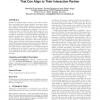Free Online Productivity Tools
i2Speak
i2Symbol
i2OCR
iTex2Img
iWeb2Print
iWeb2Shot
i2Type
iPdf2Split
iPdf2Merge
i2Bopomofo
i2Arabic
i2Style
i2Image
i2PDF
iLatex2Rtf
Sci2ools
ATAL
2010
Springer
2010
Springer
Adaptive expressiveness: virtual conversational agents that can align to their interaction partner
Speakers in dialogue tend to adapt to each other by starting to use similar lexical items, syntactic structures, or gestures. This behaviour, called alignment, may serve important cognitive, communicative and social functions (such as speech facilitation, grounding and rapport). Our aim is to enable and study the effects of these subtle aspects of communication in virtual conversational agents. Building upon a model for autonomous speech and gesture generation, we describe an approach to make the agent's multimodal behaviour adaptive in an interactive manner. This includes (1) an activation-based microplanner that makes linguistic choices based on lexical and syntactic priming, and (2) an empirically grounded gesture generation such that linguistic priming parallels concordant gestural adaptation. First results show that the agent aligns to its interaction partners by picking up their syntactic structures and lexical items in its subsequent utterances. These changes in the agent&...
Related Content
| Added | 08 Nov 2010 |
| Updated | 08 Nov 2010 |
| Type | Conference |
| Year | 2010 |
| Where | ATAL |
| Authors | Hendrik Buschmeier, Kirsten Bergmann, Stefan Kopp |
Comments (0)

